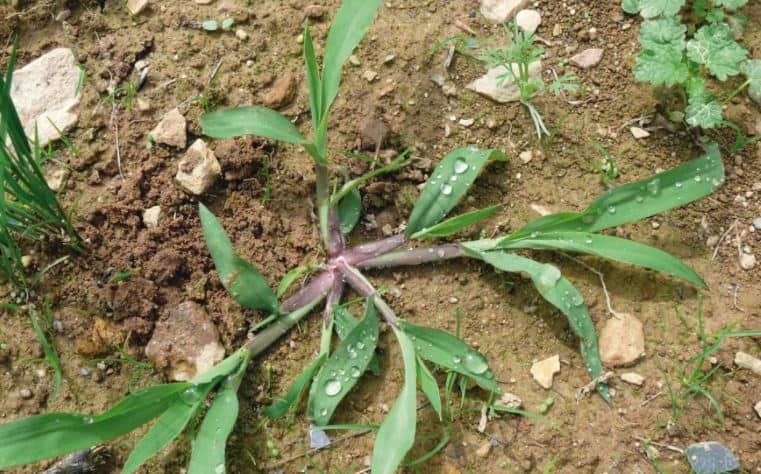Quackgrass is among the relatively common weeds you can find in your lawn. It can be easily recognized by its stalky, thick stems and wide blades. Being very common, this grass comes with a variety of names.
Even though there are several ways to get rid of this pesky weed, here are the steps for killing quackgrass with vinegar.
- Mix vinegar with orange oil
- Apply the mixture on quackgrass under direct sunlight
- Allow it to sit for a few hours
Read further to learn how to perform these steps properly.
Does vinegar kill quackgrass weed?
Vinegar can get rid of crabgrass. A strong solution of vinegar, when mixed with orange oil, can kill weeds for good. However, this process has to be done correctly, or else the weeds sprout again. Did you know vinegar is effective at controlling many other types of weeds?
Most vinegar solutions are not effective in killing weeds because they are not appropriately prepared. While most blogs will give tutorials on how to make a vinegar weed killer, most of the content offers incorrect information that does not yield any desirable results.
This is because most of these tutorials only show vinegar with an acidity of 5% which does not help kill any type of weeds, let alone quackgrass.

Household vinegar rarely kills weeds, though it may cause some of the weeds to shrivel and wilt a bit but not die off completely. Noxious weeds will need stronger agents for their complete eradication.
To ensure that you achieve better results with your vinegar solution, you need to buy vinegar that has a potent acidity of at least 10% also known as herbicidal vinegar. This type of vinegar is also a great alternative to chemical herbicides such as Glyphosate.
You should, however, be careful when handling vinegar with more than 10 percent acidity because it is very potent and dangerously corrosive. It can burn your skin almost instantly upon contact.
To keep yourself safe, wear goggles, long-sleeved clothing, rubber gloves, and shoes when you are working with 10% to 20-% vinegar solutions. It is also important to apply vinegar mixed with orange oil. Read more about natural herbicides like orange oil.
While vinegar can solely destroy weeds without a problem, it is the orange oil component that greatly completes the entire process of weed control.
How to get rid of quackgrass using vinegar
The correct ratio for killing weeds with vinegar is 1 gallon of 10%-20% vinegar to one cup of orange oil. If you have more weeds to take care of, use a type of sprayer that will cover a wide area. Here are my recommended products:
- CERTIFIED FOR ORGANIC USE — Completely eliminates and desiccates weeds and grasses without using toxic chemicals. Made straight from corn grown in the USA. OMRI listed weed killer and certified for organic use.
- KILLS WEEDS FAST — Eliminate any type of weed in just a matter of hours. Expect full desiccation in less than 24 hours. Green Gobbler contains 20% acetic acid. Use on crabgrass, dandelions, clover weeds, white clover, moss, etc. Works best for weeds exposed to direct sunlight.
- POWERFUL FORMULA — NO cancer-causing chemicals. Glyphosate-free. 20% formula is four times stronger than traditional table vinegar. Made strictly from ethanol distilled from corn grain.
Affiliate links and images pulled from the Amazon Product Advertising API on: 2024-04-26
- POWERFUL HOME CLEANER AND DEGREASER. Medina's Cold-Pressed Orange Oil is a perfect all-purpose cleaner! Our orange oil contains 98% D-Limonene, a naturally occurring and non-toxic solvent and degreaser with thousands of practical uses. Also contains 2% emulsifier surfactant.
- THOUSANDS OF PRACTICAL USES. Orange oil is an extremely versatile & powerful natural solvent. Use Orange oil to remove dirt, grease, oil, food, odors, ink, glue, crayon, soap scum, etc.
- COLD-PRESSED TO PRESERVE INTEGRITY. Heat is not used during the extraction process for the D-Limonene present in Medina's Cold-Pressed Orange Oil. The cold-pressed technique preserves the degreasing qualities of the orange oil and ensures you are receiving a powerful, natural product.
Affiliate links and images pulled from the Amazon Product Advertising API on: 2024-04-26
Here’s how to kill quackgrass using vinegar.
- Mix vinegar with orange oil well.
- Apply the mixture on quackgrass under direct sunlight.
- Allow it to sit for a few hours.
- Repeat the process if the weed does not dry and die after the first application.
This combination works best when applied at full strength in sunlight as the day gets hot. To maintain its potency, you should not apply vinegar weed killer less than 24 hours after rains or when the forecast indicates an impending rain within the next 24 hours.
This means that if it rained yesterday, you won’t be doing much damage to the weeds if you apply the weed killer today. The optimum working conditions and maximum efficacy for vinegar weed killer is at 70 degrees Fahrenheit.
Is it safe to apply vinegar on your lawn?
The major downside of this brew of vinegar and orange oil is that it is not discriminative. It kills anything in its path. Therefore, you should be careful when applying it to your lawn other wise you’ll cause damage to your entire lawn.
It kills plants, flowers, and grass just as effectively as it kills weeds. The best strategy to keep your flowers, plants, and grasses safe is to avoid the use of vinegar weed killer on windy days. You can also spot-treat quackgrass with this solution.
Natural alternatives to vinegar for killing weeds
Other than using vinegar laced with orange oil, certain alternatives are also as effective. For instance:
1. Smother the quackgrass
Ideally, it is almost impossible to kill quackgrass without killing the neighboring plants and grasses as well. Smothering will be beneficial if you don’t mind losing but a small number of plant life around the quackgrass.
In this method, a dark plastic is placed over the quackgrass so that it fits entirely inside it. Rocks or pieces of wood are then used to anchor the edges of the plastic to prevent it from falling off.
The strategy is simple, the dark plastic bag blocks sunlight and water from reaching the quackgrass leading to its death.
This technique becomes effective after about 3 to 4 weeks.
2. Solarize the quackgrass
Sometimes you might decide to overheat the quackgrass and kill it with too much sun, known as the polarizing technique. As summer sets in, you can place clear plastic bags over each patch of the weed.
After anchoring the plastic cover to stabilize it, let it stand for the sun rays to take effect. The plastic bag creates a miniature greenhouse effect and also solarizes the soil in which the grass is growing.
Although this process takes weeks to complete, the weeds eventually be eliminated.
3. Dig up the quackgrass
This technique comes with minor success but you can try it out nonetheless. Quackgrass grows with a root system called a rhizome which is deeply seated into the ground and is very hardy. With this kind of root system, it is almost impossible to completely dig out quackgrass.
Adding to this, you may break the roots as you dig out the weed and the grass will perpetually grow all over again.
However, you can try digging the weed about 1 foot deep and wide. Pull out the roots that are visible and cover the hole with topsoil. You can then cover the dug area with plastic or some thick mulch to prevent the weed from sprouting again
4. Douse with sodium hydroxide
Salt has been used since ancient times, especially during war to poison the fields of the enemy. Salt is very toxic to plants and can effectively kill weeds such as crabgrass and quackgrass. The major problem is that it doesn’t discriminate. It will kill your good plants and grass as well.
Make a solution of sodium hydroxide, and cover the nearby grass and plants that you don’t want to affect. Use a spray can to spray the sodium hydroxide solution directly onto the leaves of the quackgrass to kill it.
Conclusion
Vinegar is very potent at managing quackgrass and other weeds growing on your lawn. While there are other alternatives to vinegar as a weed killer, it is far better than most of the other techniques available. You should only master how to formulate it correctly including how to make the right proportions to achieve great results.
References
Hi, Alex Kuritz here. Growing up I remember that my family had one of the best lawns in the neighborhood. Richly green and lush. I did a lot as I grew up in terms of caring and tending for not only my family’s lawn but also my neighbors. I can say I have years of experience, and I am here to share it with you.





Will grass seed grow in the area where vinegar/orange oil or sodium hydroxide has been used to kill quackgrass?
Well? Can we roll sod over the treated area after one week?
After a week you should be safe to roll out sod over the area. I have done this multiple times and the areas grown in healthy.
When you mix strong vinegar (I have 10%) with orange oil, do you mean ORANGE TKO?
Sodium hydroxide is lye not salt (that would be sodium chloride). Very caustic like the 10%+ vinegar. My personal (and formerly professional) opinion: these mixtures are more dangerous to work with than glyphosate.
I am really perplexed by the sudden quick emergence of a quackgrass covering almost my entire lawn. My front lawn is roughly 65 X 75 and I have tried roundup , and other stuff but am not able to get rid of it . My lawn looks terrible now . If I cannot kill it, will sodding over the entire lawn be successful so that the quackgrass will never emerge again ?Ben
Hi Ben, you may want to do a few rounds of Tenacity to get rid of the quackgrass. That should do it or at least start to give you some visible results. Then once it starts to die off you can see how much area needs to fill in with the type of grass you have. Then decide if you need to seed or over sod.